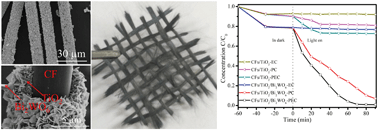Preparation of TiO2/Bi2WO6 nanostructured heterojunctions on carbon fibers as a weaveable visible-light photocatalyst/photoelectrode†
Abstract
The prerequisite for the photocatalytic application is to develop an efficient and recyclable visible-light photocatalyst/photoelectrode. Herein, we designed and prepared TiO2/Bi2WO6 nanostructured heterojunctions on carbon fibers (CFs) as an effective and weaveable visible-light photocatalyst/photoelectrode. With CFs as the substrate, TiO2 nanorods (diameter: 200 nm and length: ∼2 μm) were prepared on their surface by a dip-coating hydrothermal method and then the in situ growth of Bi2WO6 nanosheets (diameter: 350–500 nm and thickness: ∼15 nm) was realized on the surface of TiO2 nanorods by another hydrothermal treatment. When the CFs/TiO2/Bi2WO6 bundles (length: ∼4 cm and weight: 0.15 g) were floated on polluted water, they could degrade 100% Rhodamine B (RhB) after 80 min, 100% Acid Orange 7 (AO7) after 60 min, 95.1% tetracycline hydrochloride (TTCH) after 60 min, and 90.5% 4-chlorophenol (4-CP) after 150 min of visible-light irradiation (λ > 400 nm), which is higher than those degraded by pure CFs or CFs/TiO2 heterojunctions. Moreover, the CFs/TiO2/Bi2WO6 bundles can be further weaved into a cloth (area: 4 × 4 cm2). Such CFs/TiO2/Bi2WO6 cloth as a working electrode exhibited significant photocurrent, which can be enhanced by elevating the applied voltage bias. Furthermore, 100% RhB can be degraded by the CFs/TiO2/Bi2WO6 cloth in 80 min via a photoelectrocatalytic process (bias: 0.5 V vs. SCE), which is higher than that from the photocatalysis (90.1% RhB) or the electrocatalysis (21% RhB) process alone. In particular, a macroscale CFs/TiO2/Bi2WO6 cloth can be easily recycled with good stability. Therefore, the CFs/TiO2/Bi2WO6 cloth can be used as an efficient and recyclable visible-light photocatalyst/photoelectrode with a great potential in the practical applications for purifying wastewater in the river and/or lake.



 Please wait while we load your content...
Please wait while we load your content...